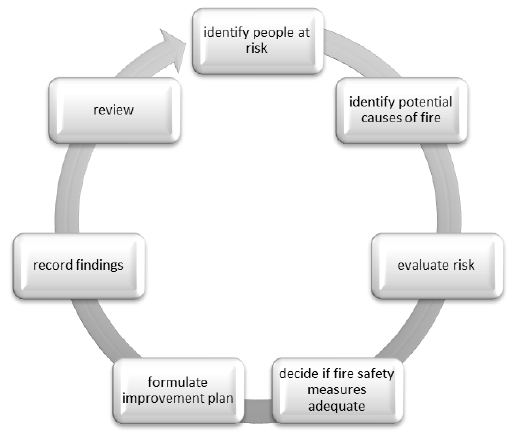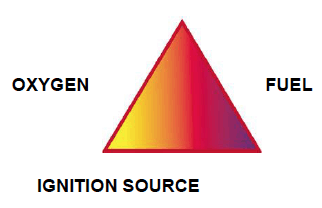Practical fire safety guidance for existing premises with sleeping accommodation: consultation
This consultation seeks views on revised and consolidated fire safety advice for residential premises with sleeping accommodation.
Chapter 2: Assessment Of Fire Risk In Premises
46. Where fire safety law applies, it is a legal requirement to assess the premises to identify risk to persons from fire and to take fire safety measures. The assessment of risk should be specific to fire safety and to the specific premises concerned. A generic risk assessment will not be sufficient.
47. Fire safety risk assessment is a practical exercise aimed at evaluating the risk from fire and how to ensure the safety of persons in the event of fire. It involves an organised and methodical look at the premises, the activities within the premises, the type of occupants, the potential for a fire to occur and the harm it could cause to people. The existing fire safety measures are evaluated to establish whether they are adequate or if more requires to be done. In this respect, fire safety measures include not just physical measures, such as fire alarm systems and escape routes, but also standards of management.
48. The risk assessment process described in this chapter is shown in Figure 1.

Figure 1 - Fire safety risk assessment process
Identify People at Risk
49. An assessment should be made of those persons at risk if a fire occurs within or in the immediate vicinity of the premises. The number, characteristics and location of occupants, residents, staff and other persons who frequent the premises should be identified. Disabilities should be taken into account along with peoples’ familiarity with the premises. The inexperience, lack of awareness and immaturity of any young persons (under 18 years) employed or resident, should be also considered.
Identify Potential Causes of Fire
50. For a fire to start, three components are needed: a source of ignition; fuel; and oxygen. These components can be represented as the sides in a simple ‘triangle of fire’ model shown in Figure 2. If any one of these components is missing, a fire cannot start. Taking steps to avoid the three coming together will reduce the chance of a fire occurring, while reducing the quantity of oxygen (smothering) or fuel (starvation) may restrict the development of a fire.

Figure 2 - Triangle of fire
51. The premises should be critically examined to identify potential ignition sources and materials that might fuel a fire and the circumstances which might allow a fire to start. Any previous fires should also be considered, as should indications of ‘near misses’ such as scorch marks on furniture or fittings, discoloured or charred electrical plugs and sockets or cigarette burns. Some general information and examples are given in Tables 1 to 3 at the end of this chapter and recommendations on controlling ignition sources are contained in Chapter 5.
Evaluate the Risk
52. The risk in the premises should be evaluated so that a judgement can be made on the adequacy of fire safety measures. Risk has two components: the likelihood that a fire may occur; and the potential for a fire to cause death or injury i.e. consequence. Both likelihood and consequence should be considered when assessing risk.
53. The likelihood of a fire starting will be low if there are few ignition sources, and if combustible materials are kept away from them.
54. Having considered the people likely to be at risk should a fire start in the building and the chances of a fire occurring, the consequences and extent of the risk to those people if a fire starts and spreads should be considered. In evaluating the risk to people, it is necessary to consider different situations and possible scenarios such as:
- fire starting on a lower floor affecting the escape of people on upper floors
- the potential for fire to affect escape routes, particularly where there is a single escape route
- fire developing in a space that people have to pass by to escape from the building
- fire or smoke spread through a building via routes such as vertical shafts, service ducts, service penetrations, ventilation systems, cavities, roof voids and open doors
- fire and smoke affecting the behaviour of occupants
- the contribution to fire spread and development if dangerous substances are involved
- fire and smoke spread into the premises from exterior fires
- the potential for fire originating in the premises to pose a threat to persons in the surrounding area
55. Additionally where the building is in multi-occupancy such as a flatted building, or is multi-use such as a mixture of offices and flats, specifically consider:
- the risk from a fire which may occur in communal parts or in another part of the building occupied by a different person
- the risk which a fire in the premises may pose to other occupiers of the building and any adjoining premises
56. If there have been any previous fires in the premises, considering the circumstances and lessons learned may assist with evaluating risk.
Decide if Existing Fire Safety Measures are Adequate
57. A judgement needs to be made to determine whether the fire safety measures and fire safety arrangements are adequate or if more needs to be done to safeguard persons. The level of fire safety measures provided in premises should be proportionate to the level of risk posed to the safety of people and will therefore vary between premises.
Formulate an Improvement Plan
58. Carrying out an assessment of the premises is not an end in itself. The outcome of the risk assessment needs to be acted upon; risks need to be controlled in a practical way and fire safety measures and arrangements need to be put in place.
59. Potential causes of fire identified should be avoided or removed, if reasonably practicable to do so. If they cannot be removed, measures should be taken to control the risks.
60. Where improvements to fire safety measures in premises are considered necessary as a result of assessment of risk, a plan for implementation of the improvements should be drawn up. The plan should have priorities and timescales for the completion of the action required.
61. Where improvements involve building work, the work should be done in accordance with Building Regulation procedures. In a listed building (a building of special architectural or historic interest included in a list compiled by the Scottish Ministers), alternatives to conventional fire safety measures may be appropriate. Guidance is available in Guide for Practitioners 7 Fire Safety Management in Traditional Buildings issued by Historic Scotland.
Record the Findings
62. Having carried out a fire safety risk assessment of the premises, fire safety law requires that certain information be recorded where five or more employees are employed by an employer (whether they are on the premises or not) or the premises is subject to licensing or registration, or an Alterations Notice has been issued requiring this. Chapter 4 contains recommendations in respect of record keeping.
Review the Assessment
63. The fire safety risk assessment should be reviewed regularly and also before any significant or relevant changes are made or if relevant safety issues arise. This will involve setting time aside to consider whether change has affected the risk and whether fire safety measures remain appropriate.
64. Where changes are proposed, the consequence to fire safety in the premises should be considered before the change is introduced. Changes that might prompt a review of the risk assessment include:
- a change in the number of people present or the characteristics of the occupants
- changes to work procedures, including the introduction of new equipment
- alterations to the building, including the internal layout
- significant changes to furniture and fixings
- the introduction or increase in the storage of dangerous substances
65. A review should occur on becoming aware of shortcomings in fire safety measures, potential improvements, or a fire or ‘near miss’ occurs which may indicate that the existing fire safety measures are inadequate. If the Fire and Rescue Service has attended a fire in the premises, its fire investigation findings may help inform a review.
66. In any case, a review of the fire safety risk assessment should be carried out regularly. This will involve setting time aside to consider whether there has been any change which would affect the risk and therefore confirming that the control measures are still appropriate.
67. Generally, reviews of a risk assessment should be carried out in-house by the premises management. This will reinforce ownership of fire safety management and assist in the development of relevant knowledge and of a fire safety culture. However where significant changes to premises have occurred, it may be advisable to seek specialist advice.
Table 1 – Ignition Sources
Potential ignition sources are those where sources of heat could get hot enough to ignite material. This could include:
|
Table 2 - Fuel
Material which will burn and is in enough quantity may provide fuel for a fire. This includes contents, fixtures, fittings, structure, wall and ceiling linings and surfaces. Some examples of ‘fuels’ are:
|
Table 3 - Oxygen
| The main source of oxygen for a fire is in the air around us. Air supply can be by natural air flow through doors, windows and other openings; or mechanical air conditioning systems and air handling systems. Buildings may have a combination of sources capable of introducing or extracting air. Potential sources of oxygen supplied to a fire can be reduced by:
The action may be a precaution taken in case a fire starts, such as keeping certain doors closed. In other cases, the action may take place once a fire is detected, such as when ventilation equipment is shut down (either manually or automatically), or when doors are closed, either manually or by the automatic release of hold-open devices. High concentrations of oxygen pose a special hazard. |
Contact
Email: Linda White
Phone: 0300 244 4000 – Central Enquiry Unit
The Scottish Government
St Andrew's House
Regent Road
Edinburgh
EH1 3DG
There is a problem
Thanks for your feedback